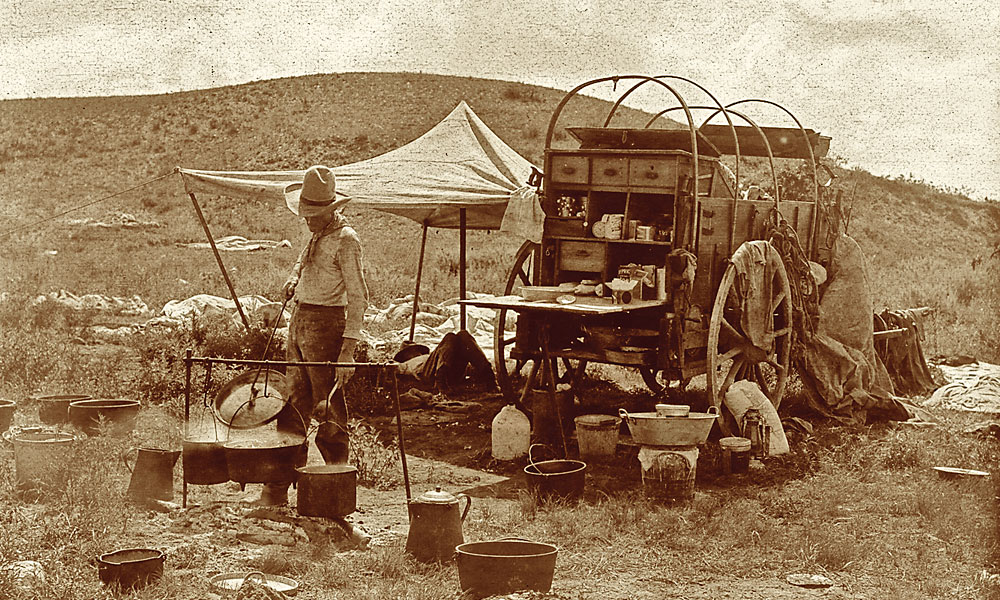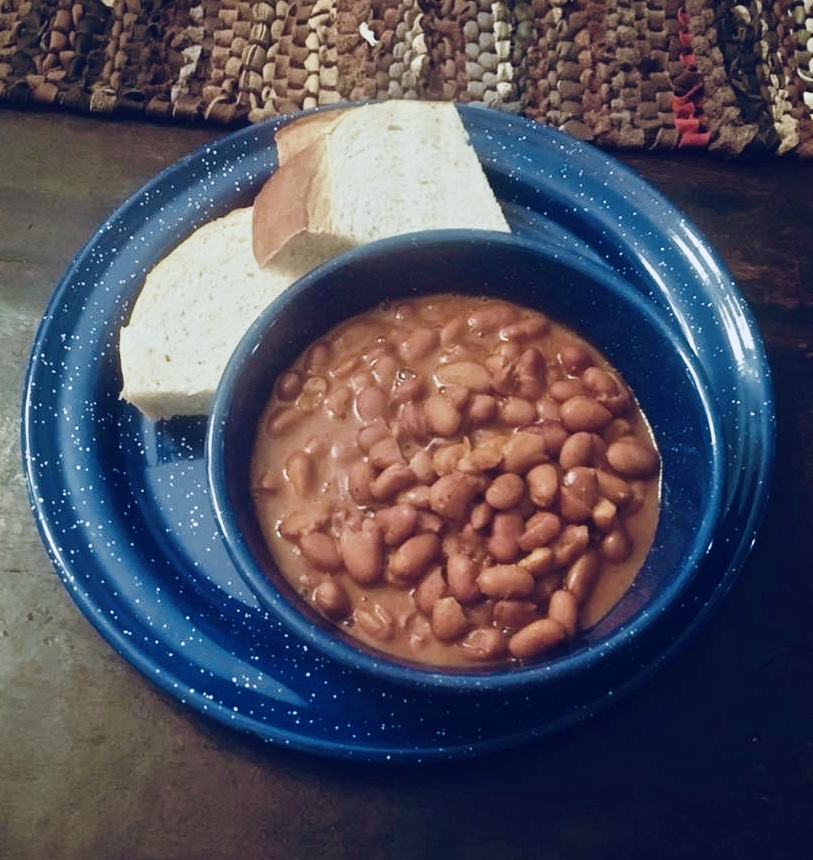If you’ve ever wondered what cowboys would eat on the open range, you’ve come to the right place. Unlike the variety of foods prepared for both cowboys and non-cowboys to eat today, what cowboys were known to eat in the 1800s and early 1900s were generally categorized into three groups. I call them the staples, the extras and the treats.
After spring roundups, cowboys herded their cattle on the trail towards a midwestern railroad station where the cattle could be shipped to the Eastern markets of New York, Philadelphia or Boston. And, as cattle drives increased in the 1860s, cooks (or “cookies” as they were often known) experienced increasing difficulties in feeding the hungry mouths of the crews tending to all those cattle. That’s about the time when a Texas Ranger and rancher named Charles Goodnight invented the chuckwagon, and in 1866, partnered with rancher Oliver Loving to create the Goodnight-Loving Trail to move their cattle to railheads.

And, on the long days and nights on the trail, food was as important as you could imagine because it provided the working cowboy with comfort and nutrition. On most days, cowboys were served two meals out of the chuckwagon: breakfast and the evening supper, with a noon meal usually taken horseback and served from a cowboy’s saddle bags.
The staples
Along the trail, the staples of a cowboy diet consisted of beans, hard biscuits, dried meat, dried fruit, and coffee. Occasionally, a type of bread known as pan de campo (or “camp bread”), which was cooked on a skillet was also available. These along with a little bit of sugar were the staples of the chuckwagon pantry.
By dawn each morning, cookie had breakfast ready. As the wrangler returned with the remuda of horses, the cowboys rose from their bedrolls, put on their hats and boots—always in that order—and straggled over to the chuck wagon for their morning coffee. The coffee was the always the same, with the cook pitching fistfuls of roasted Arbuckle beans into a pot of boiling water. According to trail lore, occasionally the cook threw a horseshoe into the pot. If the horseshoe sank, it was said, the coffee wasn’t quite ready! Remember, these were hearty times on the open range.

Beans made up the bulk of a cowboy’s protein intake. Provided in large quantities in their rations, beans were one of the most abundant foods in a traveling cowboy’s diet. Because beans were readily available and easily transported, many recipes on the cattle drives of the American West called for beans, including chili, mashed beans and bean soups. Cooked in a cast iron “dutch” oven overnight, beans could last for many meals; some cowboys even repurposed the leftovers by forming them into patties and re-frying them later.
Dried meat was another important part of the cowboy diet, providing protein and energy for the long days on the cattle drive. The cowboy version of dried meat was similar to modern jerky, but was drier and not as heavily seasoned as we enjoy today. But, still, it was easy to pack into a saddle bag, and could be enjoyed at any time of day and under most any weather condition.
Cowboy biscuits contained only flour, water and salt. They became hard, brittle and very dry after baking for a long time at a low temperature. Although they were sometimes eaten with a cowboy’s bare hands, most cowboys used the biscuits to sop up coffee, ate them as mush, or crumbled them into stews.
“It’s okay to eat with your fingers. The food is clean.”
– Chuckwagon Etiquette
Dried fruit supplemented the starch and protein that composed the mainstay of the cowboy’s diet. Dried apples, raisins and apricots were common, but berries and prunes also were available. In addition to eating it plain, dried fruit reconstituted in water with crumbled biscuits formed the basis of simple steamed cobblers and puddings.
The extras
Interestingly, cowboys couldn’t always access fresh beef, for the more cattle delivered to railheads made for more profit, and ranchers did not look kindly on his cowboys eating all his profits! Most chuckwagons, however, occasionally had prepared deer or antelope that a cowboy killed, in addition to beef from cattle that were no longer able to be driven. These meats would be fashioned into stews and slop, and provided the cowboy a heavy, filling meal. A favorite dish on the trail was known as “Son of a Gun Stew” — a kind of soup made from an animal heart, liver, and tripe. Truly delicious!
Hard cheese was an important extra in the rations provided for cowboys by their employers. Dried until hard and dipped in paraffin wax, hard cheese could last for months without spoiling and was nutritionally important due to its high content of fat, protein, calcium, and salt. Although the hard cheeses of the Old West were palatable, they were seldom eaten raw. Instead, cowboys added hard cheese to chili beans or cooked them inside biscuits using a Dutch oven.
Salted pork is a cut from the belly and sides of a pig, which is cured in salt to preserve freshness using one of the oldest food preparation techniques available. It’s similar to modern-day bacon, although salt pork was not smoked and was not as lean as bacon. Together with eggs, when available, salt pork had the benefit of satisfying the cowboy with a hearty breakfast meal, and provided a sufficient sodium intake to ward off dehydration.

Corn dodgers were the Old West precursor to the modern day corn dog, only without the hotdog in the middle! Made from simple ingredients of cornmeal, salt and boiling water, corn dodgers were hand formed and then fried in salt pork grease to make a delicious treat favored by cowboys on the open range and movie cowboys alike.
The treats
American cowboys and ranchers in the 1800’s learned of sarsaparilla from the Indian and Spanish peoples they worked with. Brewed from a herb, smilax medica, it had been brought to Europe in the 16th century by returning Spanish soldiers as a cure for syphilis. While not a reliable cure, with the plant’s general strengthening and energizing benefits, sarsaparilla was a useful and beneficial treatment, nonetheless, for many other conditions. And, cowboys became accustomed to the drink, partially due to the quack doctors of the day, who falsely claimed sarsaparilla could cure anything and everything.
Fresh fruits and vegetables, including corn, tomatoes, apples and squash, were a welcome treat for any cowboy on a cattle drive. While vegetables were a plentiful staple for those pioneers who moved westward in the early- to mid-1800s, vegetables were so perishable that they were not a suitable option for the chuckwagon. So, when cowboys could get their hands on fresh vegetables and fruits, they were more than happy to scarf them down without so much as a single word. Cowboys, you see, eat first and talk later.
Modern cowboy cuisine
Today, modern cowboy cooks, who draw from a long, proud tradition, are revered by ranch hands everywhere, even if their methods have improved and recipes modernized with time. From Grady Spears to Kent Rollins, so long as there are cowboys tending to cows in a pasture and looking after the land from the saddle, there will be a need for, and respect from working cowboys for the efforts of these purveyors of cowboy cuisine.

Around our place, we focus on modern adaptations of traditional cowboy fare, with most of it cooked in either a well-seasoned cast iron skillet or over an open flame, just as cookie did from his chuckwagon. While cowboy cooking recipes are plentiful on the internet, we tend to focus on incorporating the traditional staples of the working cowboy, combined with modern additions of our own, to create savory modern classics, be it breakfast hash or a hearty rancher’s pie.
So, if you want to eat like a cowboy, you could saddle up your pony, pack your saddle bags with beans, hard biscuits, dried meat, dried fruit, and coffee, and head out on the open range. Conversely, you might consider enjoying a meal from Grady Spears, Kent Rollins, or any other of the modern cowboy chefs, and save yourself the dusty days on the trail and the cold nights under the stars. Whichever route you take, mis amigos, you too can enjoy the simple, hearty fare used to fuel cowboys on the open range for over a century. Cowboy cooking is fun. Cowboy cooking is tasty. And, cowboy cooking connects us to our western heritage.
So, enjoy your culinary journey, and until next time, happy trails! ★